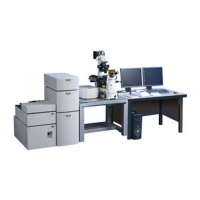Chapter 17. Exporting ND2 Files A1
49
(4) Select details about conversion.
[Apply LUTs]:
Select this when you want to convert an image whose contrast is edited by [LUTs].
[Insert Overlays]:
Select this when you want to convert an image that contains a scale bar or measurement result.
Only overlapping images can be saved.
(5) Select a channel to be saved.
[Mono image]: A single channel is saved in monochrome.
[Color image]: A single channel is saved in color.
[Channels merged into color image]: Overlapping images are saved.
(6) To save an image as a TIFF file, specify TIF Compatibility (bit conversion).
[Keep bit depth]: Saved as a 12-bit file.
[Scale 12bit to 16bit]: Saved as a 16-bit file.
[Scale 12bit to 8bit]: Saved as an 8-bit file.
<Combination of Channel, TIF Compatibility Options, and Insert Overlay>
Depth 12 bit to 16 bit 12 bit to 8 bit
Mono image 12 bit 16 bit 8 bit
Color image 12 bit RGB 16 bit RGB 8 bit RGB
Channel merged
Multi tif
12 bit
Multi tif
16 bit
Multi tif
8 bit
Channel merged
+ Insert overlay
12 bit RGB 16 bit RGB 8 bit RGB
Image: Image on a single channel Merged: Overlapping images
Light yellow: Output in color
Exporting a tif file that contains time lapse images with acquisition time
(1) Right-click on a time lapse image and select [Display ND Information] - [Acq.Time] from the displayed
menu to display acquisition time on the image.
(2) Click
at the side of the image frame to set the image display size to 100%.
(3) Select [Edit] - [Create Full View Snapshot] from the menu bar to capture the screen.
(4) Perform Steps (1) to (3) in Chapter 17, “Exporting ND2 Files” to export images as a TIF file.
(4)
(5)
(6)

